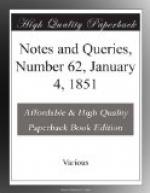E. VENABLES.
* * * * *
RED BOOK OF THE IRISH EXCHEQUER.
On one of the vellum leaves of which the Red Book of the Irish Exchequer is composed, there is depicted a pen and ink sketch of that court. In the centre of the picture is the table, which is covered (as it is at this day) with a chequered cloth, whereon are placed a bag upon which are the words “Baga cum rotulis,” a book with a clasp, five large pieces of money, and a strip of parchment, upon which is written, “Ceo vous, &c.” The table is surrounded on its four equal sides by thirteen human figures, namely, six at the top of the picture, three on the left hand, three on the right, and one at the bottom. Of the six figures at the top of the sketch, all of whom wear robes, he who is on the right hand holds a wand, bears upon his head a cap, and is in the act of leaving the court, exclaiming, “Ademayn.” To the right of this man, who is probably the crier of the court, is one of the officers carrying a piece of parchment, upon which is written in contracted law Latin, “Preceptum fuit Vicecomiti per breve hujus Scaccarii.” To the right of the last-named figure is another officer of the court, who is in the act of examining his pen by placing its nib at a short distance from his eyes; and this person carries in his left hand a piece of parchment upon which are written, in like character, the words “Memorandum quod x die Maii, &c.” To the right of this officer, who is probably the Chief Remembrancer, is placed another officer, wearing a cap, who is in the act of writing upon a piece of parchment bearing the words “Henricus dei gratia.” The two remaining figures at the top of the picture are apparently conversing together: to one of them are applied the words, “Eynt bre vic.,” with another word following the last which {7} is scarcely decypherable; and to the other the word “Elgyn” seems to have reference; such word being placed upon the ample sleeve of his gown. The three figures on the left of the picture are probably the three Barons. The head-dress of the judge who is sitting at the extreme right of the bench, varies in its form from that which is worn by the baron who is seated in the centre; and the third baron, who is sitting at the left, has his head uncovered. The first-named baron seems in the act of counting or reckoning the pieces of coin which are placed before him upon the table, and says “xx d.;” the baron in the centre, who wears a cap similar in form to the night-cap now commonly used, says “Voyr dire;” and the third baron says “Soient forfez.” Opposite to the judges, and to the right of the picture, are three persons wearing gowns, and standing at the bar of the court. One of these points towards his face with the first finger of his right hand, and says, “Oy de brie;” the figure to his left extends his right arm towards the bench, and exclaims, “Soit oughte;” and the third figure says, “Chalange.” This man,




